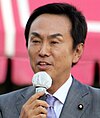| |||||||||||||||||||||||||||||||||||||||||||||||||||||||||||||||||||||||||||
All 127 seats in the Tokyo Metropolitan Assembly 64 seats needed for a majority | |||||||||||||||||||||||||||||||||||||||||||||||||||||||||||||||||||||||||||
|---|---|---|---|---|---|---|---|---|---|---|---|---|---|---|---|---|---|---|---|---|---|---|---|---|---|---|---|---|---|---|---|---|---|---|---|---|---|---|---|---|---|---|---|---|---|---|---|---|---|---|---|---|---|---|---|---|---|---|---|---|---|---|---|---|---|---|---|---|---|---|---|---|---|---|---|
| Turnout | 54.49%( | ||||||||||||||||||||||||||||||||||||||||||||||||||||||||||||||||||||||||||
| |||||||||||||||||||||||||||||||||||||||||||||||||||||||||||||||||||||||||||
 | |||||||||||||||||||||||||||||||||||||||||||||||||||||||||||||||||||||||||||
| |||||||||||||||||||||||||||||||||||||||||||||||||||||||||||||||||||||||||||
Prefectural elections for the Tokyo Metropolitan Assembly were held on 12 July 2009. In the runup to the Japanese general election due by October they were seen as an important test for Taro Aso's ruling coalition of the Liberal Democratic Party (LDP) and the New Komeito. New Komeito considers Tokyo as an important stronghold and had repeatedly asked Prime Minister Aso to avoid holding the two elections within a month of each other. [1]
Campaigning officially started on July 3, 2009. [2] The prefecture's 10.6 million registered voters (up 230,000 from 2005) were called upon to elect the 127 Assembly members in 42 electoral districts at 1,868 polling stations across Tokyo. [3] 221 candidates had been formally registered with the Tokyo metropolitan electoral commission. The LDP and the Democratic Party of Japan (DPJ) each endorsed 58 candidates, the Japan Communist Party (JCP) supports 40 and New Komeito formally fields 23 candidates, [4] though it has also decided to support LDP candidates in several districts. [5] Local campaign issues included Tokyo's bid for the 2016 Olympic Games and governor Shintaro Ishihara's plan to relocate the Tsukiji fish market in 2012. [6] The national debate over a possible ban of "hereditary" (世襲, seshū) politicians has also affected several candidates. [7]
Tokyo's legislative election is one of only three elections for prefectural parliaments countrywide that are not held in the "unified regional election" (tōitsu chihō senkyo, last round: 2007), the other two being Ibaraki's and Okinawa's prefectural assembly elections.
Results
Polls closed at 8:00 pm Japan Standard Time. Turnout was significantly up from 2005 and stood at 54.5 percent. The DPJ picked up 20 seats and saw 54 of their 58 candidates elected. The LDP lost its status as strongest party in the Metropolitan Assembly for the first time since 1965. Despite strong results for coalition partner Kōmeitō, the ruling camp could not defend an absolute majority (64 seats). [8] [9] [10] The only electoral district where an LDP candidate received the most votes (top tōsen) was the single-member [Izu and Ogasawara] islands electoral district of former assembly president Chūichi Kawashima, [11] a native of Ōshima town who had represented the islands since 1985.
| Parties | Candidates | Votes | % | Seats |
|---|---|---|---|---|
| Democratic Party of Japan (民主党, Minshutō) | 58 | 2,298,494 | 40.79 | 54 |
| Liberal Democratic Party of Japan (自由民主党, Jiyū Minshutō) | 58 | 1,458,108 | 25.88 | 38 |
| New Komeito Party (公明党, Kōmeitō) | 23 | 743,427 | 13.19 | 23 |
| Japanese Communist Party (日本共産党, Nihon Kyōsan-tō) | 40 | 707,602 | 12.56 | 8 |
| Tokyo Seikatsusha Network (東京・生活者ネットワーク) | 5 | 110,407 | 1.96 | 2 |
| Social Democratic Party (社民党 Shamin-tō) | 2 | 20,084 | 0.36 | 0 |
| Others | 13 | 45,329 | 0.80 | 0 |
| Independents | 22 | 250,869 | 4.45 | 2 |
| Total (turnout 54.49%) | 221 | 5,705,441 | 100.00 | 127 |
| Source: Tokyo electoral commission [1] | ||||
Aftermath
The president of the LDP's Tokyo prefectural federation, one of governor Ishihara's then two sons in the national House of Representatives, Nobuteru, initially hinted to step down as LDP Tokyo chief, but eventually stayed on. Nationally, Tarō Asō came under pressure within his party to resign immediately as party president-prime minister, [12] but could avoid a leadership challenge by calling the general election of the House of Representatives early [13] – the election on August 30 resulted in a landslide loss for the ruling coalition.
Democrat Ryō Tanaka from Suginami was elected assembly president, Kantarō Suzuki (Kōmeitō, Arakawa) became vice president. The assembly majority in the new assembly is often involved in disputes with governor Ishihara over the budget, the Tsukiji relocation and other issues. [14] [15] [16] Yet, in the gubernatorial election of 2011 (part of the unified regional election), Ishihara was safely reelected for a fourth term.
References
- ^ "Aso leaning toward early August election. LDP executives may also be reshuffled to boost poll numbers". The Japan Times. June 28, 2009. Retrieved June 29, 2009.
- ^ TMG Electoral Commission: Tokyo election schedule Archived 2009-07-09 at the Wayback Machine (in Japanese)
- ^ TMG Electoral Commission: 平成21年執行東京都議会議員選挙執行計画の概要 Archived 2009-07-14 at the Wayback Machine
- ^ "Tokyo poll campaign starts / 'Ishihara ruling bloc,' DPJ battling for majority in assembly". The Daily Yomiuri. July 4, 2009. Retrieved July 3, 2009. [ dead link]
- ^ "Campaigning kicks off for Tokyo Metropolitan Assembly election". Mainichi Daily News. July 3, 2009. Retrieved July 3, 2009. [ dead link]
- ^ Mariko Katō (July 1, 2009). "Key gripes converge in Tokyo poll. Opposition hits Tsukiji move, Olympics, Shinginko". The Japan Times. Retrieved July 3, 2009.
- ^ "都議選でも注目、どうなる世襲への審判". Yomiuri Shimbun. June 16, 2009. Retrieved June 29, 2009.
- ^ NHK: NHK 都議選 開票速報 Archived 2009-07-14 at the Wayback Machine
- ^ Yomiuri Shimbun: 特集>東京都議選2009
- ^ Asahi Shimbun: 特集 東京都議選2009
- ^ Jiji Press, July 12, 2009: 民主得票率、16ポイント増
- ^ The Japan Times, July 15, 2009: Aso attacked on all fronts. LDP feuds; opposition smells blood
- ^ The Japan Times, July 17, 2009: Aso foes unlikely to block dissolution. Petition by third of LDP seeking ouster appears destined to fail
- ^ The Japan Times, July 14, 2009: Ishihara must face the opposition. Shinginko, other projects now in doubt
- ^ The Economist, October 28, 2010: Fish fight. Tokyo’s governor is starting to look like yesterday’s sushi
- ^ The Japan Times, October 23, 2010: Tsukiji to relocate to Toyosu: Ishihara. DPJ ranks vow to block budget for shift to toxic site


